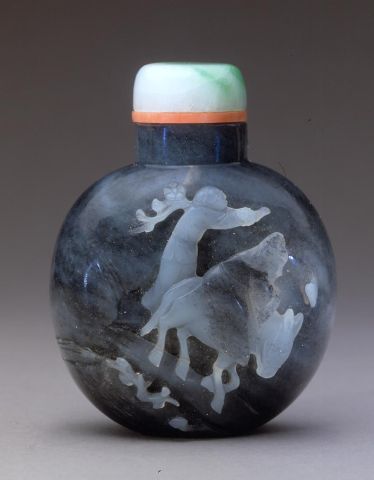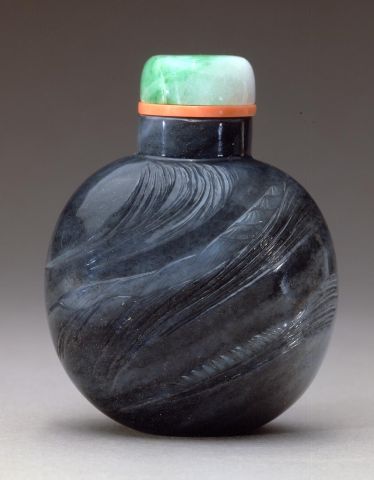

Bottle ID: 85
BLACK AND WHITE, SAGE WITH CLOUDS AND ROCK
Date: 1750-1800
Height: 55 mm
Nephrite, of black, gray and white tones, very well hollowed, of rounded bulbous form, skillfully carved on the front to depict a wintry scene with Meng Haoren, dressed in a dark robe, riding a white donkey down a slope flanked by small sprays of fungus growing from serrated rockwork, an attendant walking behind with a branch of prunus across one shoulder, the reverse elegantly carved with sweeping diagonal tiers of rocks and clouds.
Attributed to the Suzhou School.
Similar Examples:
Crane Collection nos. 381 and 459
Sotheby's, New York, September 15, 1998, lot 385, Neal W. and Frances R. Hunter Collection.
JICSBS, Autumn 1995, pp. 9-10, figs. 18 and 23.
Sotheby's, New York, September 14, 2010, lot 189, The Joe Grimberg Collection.
Provenance:
Clare Lawrence Ltd.
Sotheby's, Hong Kong, November 16, 1989, lot 139
The Kaynes-Klitz Collection
Exhibited:
Annual Convention ICSBS New York, November 2013
Published:
JICSBS, Autumn2007, front cover
JICSBS, Spring 1990, p. 22, fig. 10
The snuff bottle world is rather more specific than in the rest of the Asian art world when it refers to the Suzhou School of carving, although it is are not necessarily more accurate. Essentially this label refers to a recognizable group of bottles which share the following predominant features:
- The portrayal of naturalistic subject matter which is less formalized than "Imperial" subject matter.
- The use of the natural fissures and colors in the stone to highlight the design.
- The occurrence of spurious signatures and poetic inscriptions.
- The ability of the carver to work through several planes of stone.
- The translation of lapidary techniques over to different materials such chalcedony and crystal.
Objects, including snuff bottles from the Suzhou school are recognized by these specific characteristics which together form a unified group. However, this is not a fixed list, but a more general set of rules. It is the overall concept which is more important and which in the minds of the carvers have allowed them to produce bottles, and other works of art, which transcend the mundane by freeing them from the constraints of their everyday activities. This concept is realized through the design where every part of the stone including its natural inclusions is used by the carver producing a three dimensional sculptural effect. This is achieved in a number of ways, for example, by using the different planes of carving and undercutting which produce works that are sculptural in nature and with perspective. The shape of bottles from the Suzhou School in both nephrite and chalcedony is strikingly consistent. Generally of a rounded or ovoid form with no footrim, they allow the maximum amount of space for the design with the simple outline allowing no distractions from the more elaborate carving. The importance of form to the Suzhou School with its symmetrical regularity and plain rounded sides is that it gives the carver a freedom to develop his skills and execute the design indicated by the material without being hampered by the outer frame of the object. Even the choice of whether to have two differently carved sides or a continuous scene around the bottle is not dictated by its shape but by the markings or inclusions in the stone itself.
< Back to full list

 English
English 中文
中文